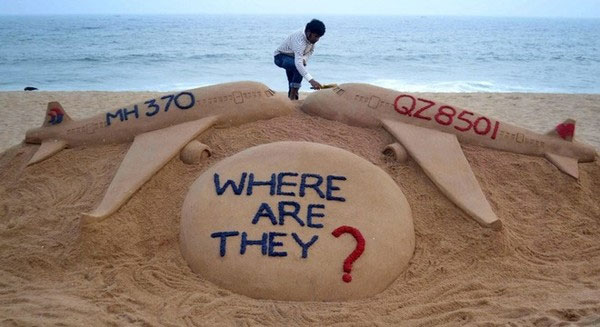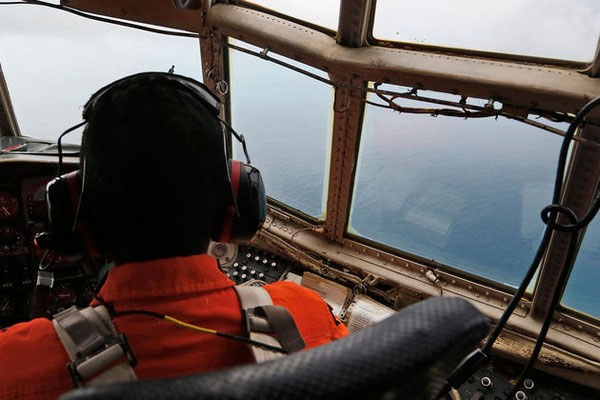Why is it difficult to find the missing plane?
Experts have recently come up with a solution to why authorities have difficulty finding the exact location of the missing plane.
>>>Why does GPS not find AirAsia aircraft missing?
>>> How is the plane tracked?
The disappearance of the recent MH 370 aircraft is the search for AirAsia QZ 8501 aircraft that many people wonder why with the advanced technology today that an aircraft can suddenly disappear without a trace. Such stain? And why are we having trouble "tracking" an airplane?

The answer given by world air traffic experts is because there are still many areas on Earth that have not been covered by radar. Most of the oceans, polar regions, or regions of Africa, Asia and South Africa still have many "blind spots" for agencies to not monitor.
This means that the navigation system of airlines is still able to "slip" the plane when the plane flies over the sea or falls into the "remote" area.

One month after the flight MH 370 disappeared from the radar on March 8, the International Air Transport Association (IATA) and a group of global commercial airlines were met to evaluate the technology being used. use. The evaluation also provided a new global monitoring system - more safe and wider to avoid recurrence of MH 370 aircraft.
Experts say that any aircraft on the move needs to be tracked in the "4D position" format - latitude, longitude, altitude and flight information every 15 minutes. At the same time, the installation of the aircraft's height rise and reduction reporting system should also be constantly updated.
The International Civil Aviation Organization of the United Nations (ICAO) recommends that airlines should not upgrade their systems and install navigation systems directly on commercial aircraft. Along with that, the aircraft should have the speed of data transfer, information in emergencies.
This will make it easier for airlines, air traffic service units and rescue dispatch centers to determine the location of the aircraft.

However, this technology is not favored by airlines because the biggest barrier is price. However, many airlines have lobbied the government for funding to install a live navigation system , because it is considered a problem of national security.
Some countries agree on the cost of installing this technology but that number is not much.
Most airlines currently rely on ACARS systems . Thanks to the ACARS system, aircraft computers can communicate with the computer on the ground and provide information about the operating status of the system on the fly.
Messages will be transmitted by radio signals or electronic signals via satellite and may cover many issues related to the status of the aircraft, from engine engines to restrooms. Important information will be sent to the ground monitoring department and the support process will be carried out quickly.

Diagram simulating the process of receiving signals and signaling from air traffic control stations and aircraft.
Another popular system used by many major aircraft carriers is ADS-B - the Automatic Surveillance Monitoring System - broadcast broadcast. ADS-B is a new technology in air traffic monitoring and management, using GPS data in aircraft tracking operations.
ADS-B will operate systems that provide "fake radar" images of aircraft in flight. These images will be used by online search agencies and included in the mapping system.

The aircraft uses the ADS-B system to locate via a satellite, then broadcast the location signal to another aircraft and to the ground station. In the United States, all aircraft are required to equip ADS-B systems from now until January 2020. This system is expected to replace future radar-based aircraft search operations.
In fact, technology that updates aircraft locations every one or two minutes has been successfully developed but is not cheap, so this system has always been considered unnecessary but relied heavily on radar systems.
With flights across the sea or through the Arctic Circle (Artic Circle), airlines will control the flight through checkpoints using ADS-B, ADS-C, or ACARS systems. Some airlines also have systems that allow monitoring of actual data on engine operation, fuel consumption, and some other systems related to flight profits.

When satellite technology was developed and became cheaper, airlines began to rely on this system to transmit flight tracking data and aircraft operation information. Jonathan Sinnatt, a spokesman for London-based Inmarsat, said: 'When ICAO made the announcement, there would be an acquisition across the airline industry, along with closer monitoring in flights'.
According to ICAO experts - whether or not the United Nations publishes official recommendations on the installation of mandatory positioning tracking devices on aircraft, management organizations in the US, Europe and Japan will be the first factors proposed to bring this project into law.
The reason is that with the increasing number of passengers, the tracking of the flight it needs quickly becomes an indispensable part - to ensure the safety of air passengers.
- Seabed mapping technology to find missing aircraft
- Why does GPS not find AirAsia aircraft missing?
- The mystery of the plane cases suddenly went missing
- Found missing Egyptian aircraft
- Hot news: American planes disappear mysteriously after taking off like MH370
- The probability of an aircraft having an accident is 0.00001%
- Decipher the mysterious plane missing MH370?
- Newly discovered fragments of missing aircraft MH370
- Uncrypted mysteries of aircraft MH370
- New shocking hypothesis about MH370
- Malaysia: 'The second metal fragment is not the plane MH370'
- Malaysia officially confirmed the drift plane debris of MH370
 'Fine laughs' - Scary and painful torture in ancient times
'Fine laughs' - Scary and painful torture in ancient times The sequence of numbers 142857 of the Egyptian pyramids is known as the strangest number in the world - Why?
The sequence of numbers 142857 of the Egyptian pyramids is known as the strangest number in the world - Why? History of the iron
History of the iron What is alum?
What is alum?